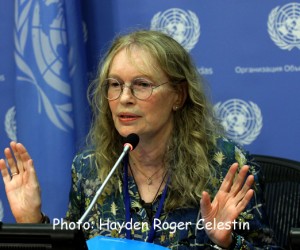
News Americas, UNITED NATIONS, New York, Weds. July 23, 2014: UNICEF Goodwill Ambassador and actress Mia Farrow is putting the spotlight on the people of the Central African Republic, who she called: “the most abandoned people on Earth.”
“There’s never going to be a time that [Central African Republic] will have the attention that it deserves,” she at the UN this week.
In November 2013, she travelled to the town of Bossangoa, where she witnessed a chaotic scene of 30,000 non-Muslims “trapped” in a church and Muslims in an abandoned school.
“Both populations were extremely traumatized with not enough of anything and NGOs [non-governmental organizations], and UNICEF and partners were working very hard to reach them with drinkable water and food. But it was the level of fear that I came away with.”
When she returned this year, she said that the entire town of Bossangoa, virtually all Muslims, had been cleansed. “Truck loads” of people had gone either to Cameroon or to Chad. Christians, too, were driven out of their homes and were seeking shelter in churches.
She said Central Africans were very much looking forward to September when UN peacekeepers will be on the ground. The UN Multidimensional Integrated Stabilization Mission in CAR (MINUSCA) will take over from the existing African-led MISCA force.
“We can’t look to them to eliminate the problem but they can quell the killing and hopefully give humanitarian aid workers access to the population,” Farrow added.
The United Nations refugee agency has called on donors to increase funding for programmes in neighbouring countries hosting refugees from the Central African Republic (CAR).
UNHCR has seen particularly serious malnutrition rates in Cameroon for over 118,000 arrivals in the last six months. Over 60 per cent of the refugees are women and children.
The appeal, backed also by 16 other agencies providing life-saving relief, is a revision of a Regional Refugee Response Plan covering the four asylum countries – Chad, Cameroon, the Democratic Republic of the Congo (DRC), and Republic of Congo – initially launched in April 2014. Today’s revised plan puts the required needs at $210 million for a targeted beneficiary population of 306,500 by December 2014. To date the amount is only 31 per cent funded.
Over 357,000 CAR refugees are in Cameroon, Chad, DRC and the Republic of Congo and some 160,000 of them have fled since December 2013 after clashes intensified between the Seleka alliance and anti-Balaka militia.
The situation is particularly worrisome in Cameroon, where a majority of the refugees are arriving. To deal with the influx of refugees there, the Revised Plan requested $111 million, almost double of what was sought earlier.
“UNHCR has seen particularly serious malnutrition rates in Cameroon for over 118,000 arrivals in the last six months. Over 60 per cent of the refugees are women and children, with a high number of unaccompanied children,” he said.
Children have indeed been affected by the region’s conflict. Since December 2013, some 17,500 have arrived in Chad, over 15,000 in DRC, with another 9,000 in the Republic of Congo.









